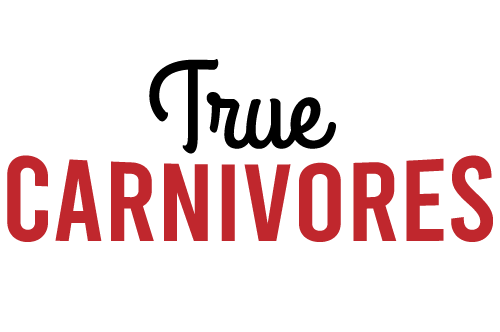It’s important to bring about awareness regarding pain in dogs and cats, simply because they are experts at hiding their pain. This is a natural behaviour that developed through evolution as it aided in their survival against predators in the wild. Now that dogs and cats are domesticated, we want to make sure they are healthy and have a good quality of life. However, this can be difficult when our pets can’t speak with us directly, so we must pay attention to all the subtle physical and behavioural signs that they display. Here are some signs to look out for when your pet is experiencing pain:
What are the signs my pet is in pain?
- Decrease in appetite
- Decreased activity and play time
- Anxiety (check out our blog post Dog Anxiety 101)
- Difficulty getting up after lying down
- Limping
- Whimpering, panting
- Excessive grooming/licking a specific area of the body
- Growling or guarding
- Reluctance to jump up or down (especially for cats)
- Changes in urination and defecation habits
- Loss of interest in social interaction
- Hiding
- Hissing or biting when touched (cats)
- Tense body posture
Every pet is different and might only display a few of these signs. The important thing is to watch your pets for a change in their behaviour.
What are the different kinds of pain?
There are two types of pain that your pet can experience: acute and chronic.
Acute Pain
Acute pain is a sudden onset of pain that is usually present for a short period of time. Some general examples include: surgery, infection, and injuries. Acute pain exists because it serves the function of signaling the brain that an area should be handled
gingerly to allow for healing. If this pain is not addressed, it may get worse and transition to chronic pain.
Chronic Pain
Chronic pain is often long-term (6 months or more) and associated with diseases such as hip dysplasia, arthritis, and cancer. The pain may persist even when the illness or injury has been treated and doesn’t have a protective purpose like acute pain does. The brain is constantly receiving pain signals, and without proper management or relief, the pain may spread to different parts of the body even without provocation.
Arthritis is one of the main culprits when it comes to chronic pain. Approximately 20% of adult dogs and nearly 80% of seniors suffer from arthritis or another joint condition. Cats are affected too, with a staggering 80-90% of cats over age 10 developing some degree of arthritis. We often attribute these behavioural changes to “old-age”, but there is usually an underlying level of chronic pain that is being overlooked.
What are the treatment options for pain?
For acute and chronic pain, a veterinarian may be able to recommend rest or prescribe pain medication such as opioids or nonsteroidal anti-inflammatory drugs (NSAIDs), depending on the level of pain experienced. While the medication may be necessary for some pets, many medications can come with adverse side effects (such as liver damage or dependence), so we prefer to try a more natural and holistic approach first. Supplements, rehabilitation therapy, and small lifestyle changes are great options to treat and manage your pets’ pain.
*If your dog is currently on any medications, please speak to your vet about possible side effects or drug interactions before introducing any new supplements to their regimen.
Supplements for Pain Management
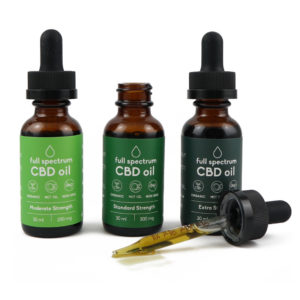
CBD (Cannabidiol)
CBD has become extremely popular in the last few years as many pet owners are looking for a natural way to relieve pain and inflammation for their pets. It also has a slew of other benefits for your pets’ overall health such as managing seizures, anxiety, cancer treatment, and skin conditions.
CBD is a great option for relieving joint pain, as it interacts directly with your pets’ Endocannabinoid System (ECS). Essentially, the ECS is a signalling system that uses endocannabinoids (a type of neurotransmitter) that bind to cannabinoid receptors, which then sends a signal to the brain that some sort of action needs to be taken. It has a regulatory role when it comes to sleep, appetite, stress, immune responses, chronic pain, and a myriad of other processes.
CBD is chock-full of phytocannabinoids, which act just as endocannabinoids do in the body. Those phytocannabinoids can activate one of the many serotonin receptors, producing an anti-anxiety effect as well as reducing the perception of pain and providing an enhanced mood. It also reduces inflammation in the body, which is the most common cause of pain. It is also believed that CBD prevents the breakdown of endocannabinoids, which allows them to have a larger effect on your body. There has also been significant research into endocannabinoid deficiency developing into other conditions, such as IBS, arthritis, and fibromyalgia. The supplementation of phytocannabinoids through CBD will provide an abundance of health benefits, but ultimately restore balance to the ECS system in the case of any deficiency, and aid in the regulation of pain.
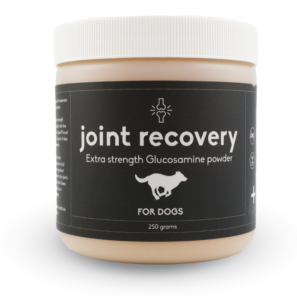 Joint Recovery
Joint Recovery
Joint Recovery is an exceptional nutraceutical that has no filler ingredients and is even classified as being pharmaceutical/human grade—if your dog doesn’t like it, take it yourself! This product has the highest concentration of ingredients known for effectively targeting joint pain, reducing inflammation in the body, and aiding in recovery.
Curcumin is a powerful anti-inflammatory that enhances the recovery of damaged tissue.
Green Lipped Mussel contains high levels of chondroitin and omega-3s, which help reduce inflammation as well as help rebuild cartilage and connective tissue.
L-Glutamine and L-Lysine are important amino acids that are known for muscle and tissue repair, as well as repairing antibodies and aiding in recovery from trauma or stress.
Glucosamine Sulfate & MSM repair cartilage—a cushion between joints that rapidly degrades with arthritis, or through gradual wear and tear with age. MSM reduces inflammation and enhances the healing power of glucosamine, which is proven to effectively relieve joint pain.
Yucca Root and Boswellia Extract are known for possessing anti-inflammatory properties on a level similar to that of Metacam. Yucca root has a reputation for being a natural pain killer due to the high level of saponins that are available.
Hyaluronic Acid is produced naturally in the body, but production decreases with age, leading to joint stiffness and restricted movement. Given as a supplement, hyaluronic acid is a great supplement for joint care as it reduces inflammation and promotes lubrication of the joints.
Vitamins E & C help by boosting the immune system to allow for fast healing and help prevent muscle degeneration.
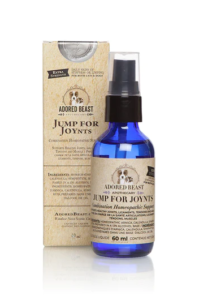 Jump For Joynts
Jump For Joynts
Jump for Joynts is a unique joint supplement made entirely from the following plants: arnica, calendula, symphytum, and ruta. It was originally created for ACL (anterior cruciate ligament) injuries, but after seeing such an improvement in dogs and cats, it was then given to pets with arthritis and joint pain as well. It comes in a liquid format and is a homeopathic alternative for surgery with no side effects!
Arnica is well-known for its use in bruising, swelling, and inflammation. Arnica contains high concentrations of selenium and manganese, which are great for bone health, wound-healing, and the metabolism of food. Food metabolism is actually a very important component of healing, as the breakdown of nutrition feeds the cells so they can function and promote healing.
Calendula contains high levels of flavonoids, which have antioxidant properties. Antioxidants protect cells from free-radicals—an unstable molecule that damages healthy cells and eventually can lead to cancer. Calendula also increases blood flow and oxygen to inflamed areas throughout the body, nourishing the cells with what they need to heal. The petals are also known for treating cuts, burns, bruises, and minor infections.
Symphytum plays a large role in healing broken bones, as it stimulates callus formation and rapidly “stitches” broken bones together. It’s also great for cartilage, tendon, and periosteum—the outer connective tissue which covers the bone—health.
Ruta, otherwise known as rue, is great for sprains, injuries, strains, bruised bones, and pulled ligaments. It is a homeopathic remedy for stiffness in the body, as well as rheumatoid arthritis and overworked joints & tendons.
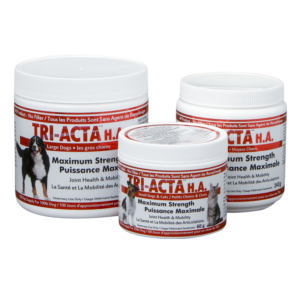 Tri-Acta Maximum Strength
Tri-Acta Maximum Strength
This formulation is similar to the Joint Recovery as a lot of the ingredients overlap—glucosamine sulfate & glucosamine hydrochloride, MSM, chondroitin sulfate, and hyaluronic acid. This is great for picky dogs and cats because there is no taste; and the concentration of the ingredients are relatively high, meaning you can use as little as a 1-gram scoop. Tri-Acta is an ideal supplement that can be used daily to proactively prevent degenerative joint conditions, alleviate the pain associated with them, and reverse the destructive process.
Tri-Acta has been optimally designed to accelerate the formation of cartilage, minimize inflammation, expedite the healing process, and improve joint condition. The addition of hyaluronic acid leads to improved viscosity of the synovial fluid, providing maximum protection and even greater results.
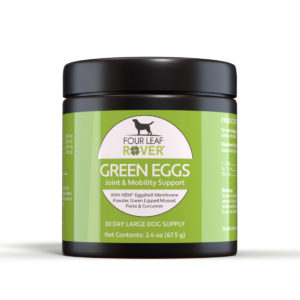 Four Leaf Rover Green Eggs
Four Leaf Rover Green Eggs
This product is made using four natural, food-based ingredients: green lipped mussel, natural eggshell membrane (NEM), poria cocos (wolfporia extenda), and curcumin.
As we’ve seen in the Joint Recovery, green lipped mussel is great for inflammation and joint pain due to its high concentration of EPA—eicosapentaenoic acid, one of several omega-3 fatty acids. Researchers are actively looking into green lipped mussel as a safer alternative to NSAIDs like Metacam and Rimadyl, as the latter are known to be hard on the liver and can cause ulcers with prolonged use.
Natural eggshell membrane is a novel supplement made from human-grade eggs that is rich in naturally occurring glycosaminoglycans, such as chondroitin sulfate, hyaluronic acid, and collagen. As covered above, all three play a major role in rebuilding joint cartilage and have anti-inflammatory effects.
Poria cocos is a mushroom that has been used for thousands of years as a natural remedy for inflammation, fatigue, memory loss, cancer, and anxiety in traditional Chinese medicine. Early studies also suggest that poria can be helpful for Alzheimer’s & type 2 diabetes in addition to joint health.
Curcumin promotes a healthy inflammatory response due to its antioxidant properties. Some researchers suspect that arthritis may be caused by oxidative stress from those unstable molecules known as free radicals. The antioxidant nature of curcumin allows for targeted healing in the joints. It is a great alternative for pets that can’t tolerate NSAIDs.
Rehabilitation Therapies for Pain Management
If you are not noticing a huge improvement after using supplements, your pet may require rehabilitation therapy, or a combination of the two. As we are not veterinarians, it would be best to ask your vet about the rehabilitation therapy options that are available for your pets, but we will list some options below that you may be able to suggest or look into.
 Acupuncture is a holistic alternative to prescribed medication and has been proven to be effective for hip dysplasia, ACL injuries, and osteoarthritis. This practice involves stimulating the nervous system with the use of needles or electrical stimulation throughout the body. Once the needle has been placed, there is an increase in blood circulation to the site and nerves that are having trouble sending signals to the brain can be “reset”, improving conditions of chronic pain like arthritis and introducing pain relief. For acute pain, only 1-2 acupuncture sessions may be recommended, but chronic pain may require multiple sessions depending on the severity of the condition. Acupuncture is also known to successfully reduce stress and anxiety, and can alleviate skin irritations like hot spots or even gastrointestinal problems.
Acupuncture is a holistic alternative to prescribed medication and has been proven to be effective for hip dysplasia, ACL injuries, and osteoarthritis. This practice involves stimulating the nervous system with the use of needles or electrical stimulation throughout the body. Once the needle has been placed, there is an increase in blood circulation to the site and nerves that are having trouble sending signals to the brain can be “reset”, improving conditions of chronic pain like arthritis and introducing pain relief. For acute pain, only 1-2 acupuncture sessions may be recommended, but chronic pain may require multiple sessions depending on the severity of the condition. Acupuncture is also known to successfully reduce stress and anxiety, and can alleviate skin irritations like hot spots or even gastrointestinal problems.
 Hydrotherapy for pets usually involves swimming or walking in warm water to treat a wide range of health conditions and soothe sore muscles & joints. Warm water is used to increase circulation and allows muscles to relax, easing joint pain. This is similar to how we humans use a hot tub to relieve muscle aches. The buoyancy of water supports overweight or disabled dogs so they can perform exercise without putting further strain on their joints, and quicker healing can take place due to increased circulation. Hydrotherapy also provides emotional support by supporting your pets’ weight, since most pets losing their mobility can experience depression and anxiety in addition to the physical stress on their joints. A session usually involves swimming with the assistance of a vest or certified aquatic therapist for 15-30 minutes—the equivalent of 1-2 hours of running but without the negative impact on the joints. A few sessions may be recommended after a surgical operation (acute pain), but chronic pain may require multiple visits to manage your pets’ pain.
Hydrotherapy for pets usually involves swimming or walking in warm water to treat a wide range of health conditions and soothe sore muscles & joints. Warm water is used to increase circulation and allows muscles to relax, easing joint pain. This is similar to how we humans use a hot tub to relieve muscle aches. The buoyancy of water supports overweight or disabled dogs so they can perform exercise without putting further strain on their joints, and quicker healing can take place due to increased circulation. Hydrotherapy also provides emotional support by supporting your pets’ weight, since most pets losing their mobility can experience depression and anxiety in addition to the physical stress on their joints. A session usually involves swimming with the assistance of a vest or certified aquatic therapist for 15-30 minutes—the equivalent of 1-2 hours of running but without the negative impact on the joints. A few sessions may be recommended after a surgical operation (acute pain), but chronic pain may require multiple visits to manage your pets’ pain.
 If needles and water are not their thing, you can also look into massage therapy for your pets! This might be the less intimidating option for rehabilitation therapy, as it reduces pain, anxiety, and stiffness through the rubbing of muscles and fascia; not many dogs and cats would pass up on pets! When done by a licensed professional, massages can help with postsurgical recovery and provide comfort for arthritic pets. Pain and anxiety are reduced by improving cardiovascular circulation in the body and relaxing muscle tissue. Chronic conditions like arthritis will not fully disappear with massage therapy, but your pets will be more comfortable. Acute conditions like a pulled muscle can be resolved with a few massage sessions.
If needles and water are not their thing, you can also look into massage therapy for your pets! This might be the less intimidating option for rehabilitation therapy, as it reduces pain, anxiety, and stiffness through the rubbing of muscles and fascia; not many dogs and cats would pass up on pets! When done by a licensed professional, massages can help with postsurgical recovery and provide comfort for arthritic pets. Pain and anxiety are reduced by improving cardiovascular circulation in the body and relaxing muscle tissue. Chronic conditions like arthritis will not fully disappear with massage therapy, but your pets will be more comfortable. Acute conditions like a pulled muscle can be resolved with a few massage sessions.
Lifestyle Changes for Pain Management
There are also many small adjustments that can be done at home to make sure your pet is comfortable. Introducing a small ramp to get up on elevated sofas or beds is recommended for aching joints, or even a rug overtop of slippery floors can make a huge impact on your pets’ confidence and comfort in the home. Raising food/water dishes to a more comfortable height will also help. If your pets will accept it, hot/cold packs can also be used on their muscles as well.
You can also modify the amount or frequency of physical activity that you are doing with your pets, such as taking shorter walks or tossing a ball a shorter distance. Chasing after a ball or jumping to catch a ball mid-air is a high impact activity that can stress the body. As your dog lands on the ground or bounds forward to catch the ball, each stride hits their bones, muscles, tendons, and ligaments with huge amounts of force, especially if your dog is overweight. This can put more stress on the joints and muscles or lead to chronic pain as your dog gets older. If your furry friend is overweight and suffering from joint pain, changes in diet and/or lifestyle to reduce their weight can take pressure off of the load-bearing joints and keep them comfortable.
